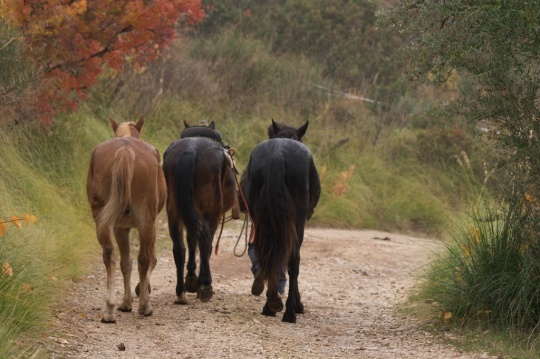Equine Welfare & Wellness: a critical review about “Natural” Horsemanship
The last decade has increasingly developing the Natural Horsemanship, a form of training based on mechanistic negative reinforcement. This method which was later developed by various schools overseas, seduces the owner of the horse creating a sensation of control of the animal. This control, however, is illusive.
The horse subjected to these method of training, learns superficially and reactively. In this way the horse is conditioned to respond precisely to the demands of human and thereby meeting the human expectations of an anthropocentric performance (see photo example below).

But the horse is a complex living being, a system linked to a number of internal variables that responds external variables. The relation and combination of these variables is never a mathematical science that is why many, many, horses respond very negatively to these techniques, arriving to express strong unbalanced emotions due to pressure, often invasive, that is applied in order to have the excellent performance training objective. These emotional unbalances go along with muscle tension states more or less evident, various forms of aggression more or less ritualized, bipolar reactive behaviour, depression, generalized anxiety.
In fact all the Natural Horsemanship methods work mainly on the emotive part of the horse brain (amygdala, thalamus, hypothalamus, hippocampus, read more on “The Emotional Brain” written by Joseph Ledoux). This is due to negative reinforcement applied during training, but not only (read more on Learning Theory and Instrumental Conditioning). The mechanical exercises and the obsessive request for a desired/correct behaviour in the horse impacts on the emotional status of this animal through the mainly activation of the fast/reactive way, and the significant less activation of the cognitive/slow way (read Ledoux).

Another big problem about Natural Horsemanship is the concept of Leadership. This concept is used as scientific concept applied to training, but in reality is far away from a scientific concept. Scientifically, in nature, social dynamics are situational, not schematical and not one-way action hierarchy. In a herd, depending on the situation, there are different horses with different resource behaviours, there is not a schematical and fixed leadership. In Natural Horsemanship the well-known claim is: “You must become leader of your horse”. This sentence may result in strong and dangerous misunderstandings.

In the video below that I have shot several years ago in the Italian territory of the semi-feral Esperia horses, a young female advances towards me with an explorative/cognitive behaviour. What does she express? How would you look to other horses behind her? Was she looked upon from the other horses as the leader or simply as a mare with more curiosity and explorative behaviour as her personal resources?
That which, as in the case of these “natural methods”, is defined as natural, in reality is out of the natural context for horses. Proponents of these “natural” ways, claim that their techniques are based on observation of the horses in nature and therefore have scientific value. If you don’t observe in an objective and scientifically prepared way, you can read anything you want as you are often trying to recognize what you already think you will see. Things are different in nature, and the extrapolation of the term “natural” does not honour the specific behavioural and social characteristics of the horse, often leaving physical, mental, social and relationship injury, more or less hidden, with a significative impact on horse welfare and wellness.
Author: Francesco De Giorgio, cognitive ethologist, equine behaviour researcher, horseman.
Photo: Internet source










